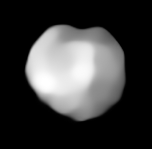(89) Julia
| Asteroid (89) Julia | |
|---|---|
 | |
| Bild von (89) Julia – aufgenommen mit dem VLT-SPHERE-Teleskop | |
| Eigenschaften des Orbits Animation | |
| Orbittyp | Mittlerer Hauptgürtel |
| Große Halbachse | 2,551 AE |
| Exzentrizität | 0,184 |
| Perihel – Aphel | 2,081 AE – 3,021 AE |
| Neigung der Bahnebene | 16,1° |
| Länge des aufsteigenden Knotens | 311,5° |
| Argument der Periapsis | 45,1° |
| Zeitpunkt des Periheldurchgangs | 31. Oktober 2021 |
| Siderische Umlaufperiode | 4 a 29 d |
| Mittlere Orbitalgeschwindigkeit | 18,47 km/s |
| Physikalische Eigenschaften | |
| Mittlerer Durchmesser | 145 km |
| Masse | (6.71 ± 1.82)·1018[1] kg |
| Albedo | 0,19 |
| Mittlere Dichte | 3.98 ± 1.27[1] g/cm³ |
| Rotationsperiode | 11,4 h |
| Absolute Helligkeit | 6,6 mag |
| Spektralklasse | Tholen: S SMASSII: K |
| Geschichte | |
| Entdecker | É. Stephan |
| Datum der Entdeckung | 6. August 1866 |
| Quelle: Wenn nicht einzeln anders angegeben, stammen die Daten vom JPL Small-Body Database. Die Zugehörigkeit zu einer Asteroidenfamilie wird automatisch aus der AstDyS-2 Datenbank ermittelt. Bitte auch den Hinweis zu Asteroidenartikeln beachten. | |
(89) Julia ist ein Asteroid des Hauptgürtels, der am 6. August 1866 von dem französischen Astronomen Édouard Jean-Marie Stephan entdeckt wurde[2].
Der Asteroid wurde nach der Heiligen Julia von Korsika, einer Märtyrerin des 5. Jahrhunderts, benannt.
Julia Familie
(89) Julia ist Stammkörper der Julia-Familie der Asteroiden[3]. Diese umfasst gut 30 Objekte.
Beobachtungen mit dem VLT-SPHERE-Teleskop führten zur Entdeckung eines ca. 70 km großen Kraters auf der südlichen Hemisphäre des Asteroiden. Dessen Bildung durch die Kollision des Hauptkörpers mit einem ca. 8 km großen Objekt wird mit der Entstehung der Asteroiden-Familie in Verbindung gebracht.[4] Der Krater ist als bis dato einzige Oberflächenstruktur auf dem Objekt nach der korsischen Gemeinde Nonza benannt worden.[5]
Einzelnachweise
- ↑ a b Benoit Carry Density of Asteriods, Planetary & Space Science, 2012, Band 73, Ausgabe 1, S. 98–118, doi:10.1016/j.pss.2012.03.009
- ↑ Discovery Circumstances: Numbered Minor Planets. The international Astronomical Union - Minor Planet Center, abgerufen am 7. August 2020.
- ↑ D. Nesvorny, M. Broz, V. Carruba Identification and Dynamical Properties of Asteroid Families, 2014, arXiv:1502.01628
- ↑ The impact crater at the origin of the Julia family detected with VLT/SPHERE? Astronomy & Astrophysics, abgerufen am 12. August 2020.
- ↑ ESO/VLT/SPHERE Survey of D>100km Asteroids : First Results. USRA, abgerufen am 13. August 2020.
Auf dieser Seite verwendete Medien
Autor/Urheber: Credit: ESO/Vernazza et al., Lizenz: CC BY 4.0
VLT's SPHERE spies rocky worlds
From the description at File:Potw1749a.tif:
These images were taken by ESO's SPHERE (Spectro-Polarimetric High-Contrast Exoplanet Research) instrument, installed on the Very Large Telescope at the Paranal Observatory, Chile. These strikingly-detailed views reveal four of the millions of rocky bodies in the main asteroid belt, a ring of asteroids between Mars and Jupiter that separates the rocky inner planets of the Solar System from the gaseous and icy outer planets.
Clockwise from top left, the asteroids shown here are 29 Amphitrite, 324 Bamberga, 2 Pallas, and 89 Julia. Named after the Greek goddess Pallas Athena, 2 Pallas is about 510 kilometres wide. This makes it the third largest asteroid in the main belt and one of the biggest asteroids in the entire Solar System. It contains about 7% of the mass of the entire asteroid belt — so hefty that it was once classified as a planet. A third of the size of 2 Pallas, 89 Julia is thought to be named after St Julia of Corsica. Its stony composition led to its classification as an S-type asteroid. Another S-type asteroid is 29 Amphitrite, which was only discovered in 1854. 324 Bamberga, one of the largest C-type asteroid in the asteroid belt, was discovered even later: Johann Palisa found it in 1892. Today, it is understood that C-type asteroids may actually be bodies from the outer Solar System following the migration of the giant planets. As such, they may contain ice in their interior.
Although the asteroid belt is often portrayed in science fiction as a place of violent collisions, packed full of large rocks too dangerous for even the most skilled of space pilots to navigate, it is actually very sparse. In total, the asteroid belt contains just 4% of the mass of the Moon, with about half of this mass contained in the four largest residents: Ceres, 4 Vesta, 2 Pallas, and 10 Hygiea.